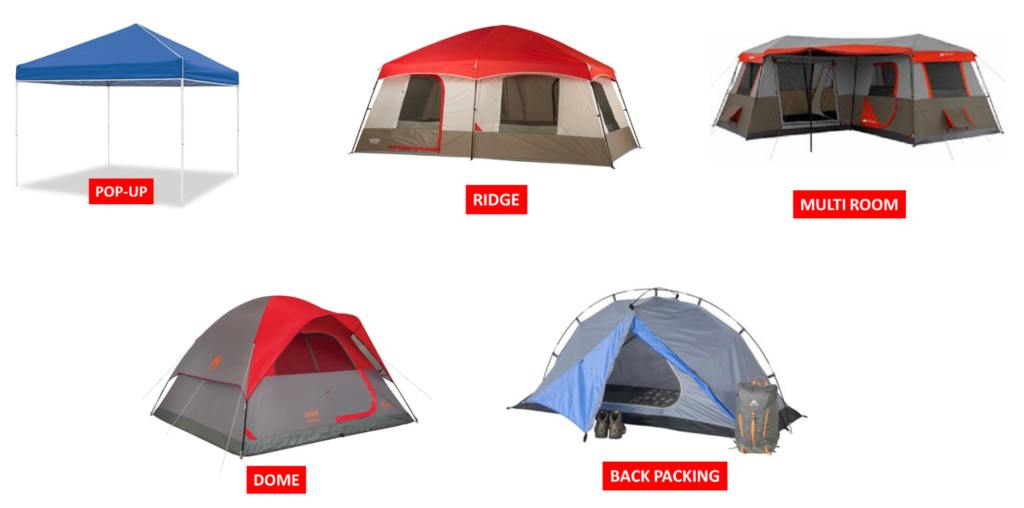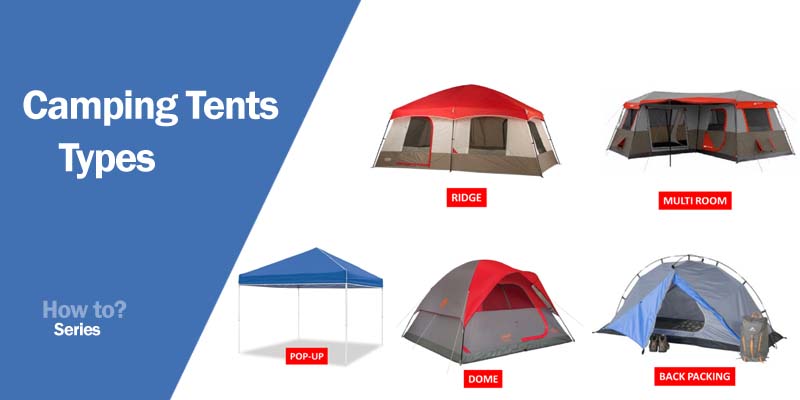Types of Tents – Complete List
There are several types of camping tents available. They are briefly discussed here but honestly; this is the least important factor you should take into account when buying the camping tents. As far as it meets your requirements, it does not matter as much as to what type of tent you buy. The important factors to consider while buying the tents are explained in the following paragraphs.

If you are new to camping, do check out other informational blogs for camping that might help you kick-start!
History of Camping Tents
One of the most enjoyable family vacation experiences is spent in the great outdoors camping. Tents that are available nowadays for family camping are much more advanced than those first tents used many years ago.
The actual history of tents is rather sketchy. It is known that centuries ago there were many people who lived nomadic lifestyles. They roamed about within a certain range, often traveling on a seasonal basis to avoid extreme weather conditions or to follow their food source which might have been buffalo, deer, moose or elk for example. This meant that everything the people owned must be easily transportable, including their homes. The hides of animals that were killed to feed the community were cleaned, cured and stretched to provide material for clothing, footwear and homes. The fabric was stitched together and stretched over wooden poles to provide individual structures within which families could sleep and be protected from the elements and the animals which hunted in the night. These were the earliest of tents, going back to Biblical times.
When military units were established and had the need to travel for battle, these portable structures were adopted to protect the men. Teepees were the first type of tents used by the North American armies; a style learned from early Native Americans. Tents remained rustic and basic until the mid 1900’s, when interest was shown in travel to colder climates. Restructuring of the tent fabrics and design began to make the structures more able to withstand the elements. It also made them bulkier and heavier. Between the 1960’s and 1970’s, camping sparked the interest of the average American and the design of camping tents changed once more to meet this newer need which was more of a recreational activity. Lighter aluminum poles were substituted for ease in toting and setting up.
As more and more people became enamored with the camping experience, they had more and more ideas on making the experience even more satisfying. Tents were improved upon over and over again to result in the type of structures available today for camping enthusiasts. In fact, the development of tents continues to this day, with additional features being included with every passing year. From the initial invention of animal hides stretched across wooden poles, people can now choose between one to six room tents, tents with built in lighting, tents with hinged exterior doors and more.
The history of tents goes back nearly to the beginning of time, as man sought some structure with the materials at hand to protect himself from the elements. Now they are used for enjoyable sojourns into the great outdoors, equipped with many of the comforts of home.
The New World of Family Camping Tents
One of the best family bonding experiences is backwoods camping, and with the variety of family camping tents available nowadays, it can be inexpensive and great fun for everyone.
Family vacations are the stuff of which long lasting memories are formed. A tent set up under a canopy of lush, green trees; a crackling, fragrant campfire, perhaps the sound of waves lapping against the shore of a crystal clear lake; the perfect setting for a fun family camping adventure. Add to that activities such as hiking, canoeing, swimming, biking and more and an ideal vacation experience has been created.
Some parents shirk at the thought of their entire family being uncomfortably closeted in the cramped confines of a tent. These are the tents of the past, however. Although small dome tents are still available for those who require such accommodations, great strides have been made in the development of family camping tents. Tents have expanded in size; extending from the single one man tent to those now featuring multiple rooms within the same structure. Dividing walls are able to separate the interior space into individual rooms when needed for sleeping arrangements, and then have the capability of being tied back to open the space during the day. This roomy atmosphere gives the tents more of a “homey” feel, and has a more inviting feel.
Another drawback to camping in a tent is the fact that our society is much more dependent upon the conveniences of life, such as electricity, and has a hard time spending even one weekend away from television, computers, hair dryers and such. Many campgrounds offer family camping sites that provide electricity; however, the sites are at an additional cost and are surrounded by other campers. The ambiance and serenity of the backwoods atmosphere are lost, unless one of the newest features in family camping tents is used. Certain family tents are equipped with power packs and 12 volt plugs to enable families to camp in the wilderness yet still enjoy the amenities to which they are accustomed.

